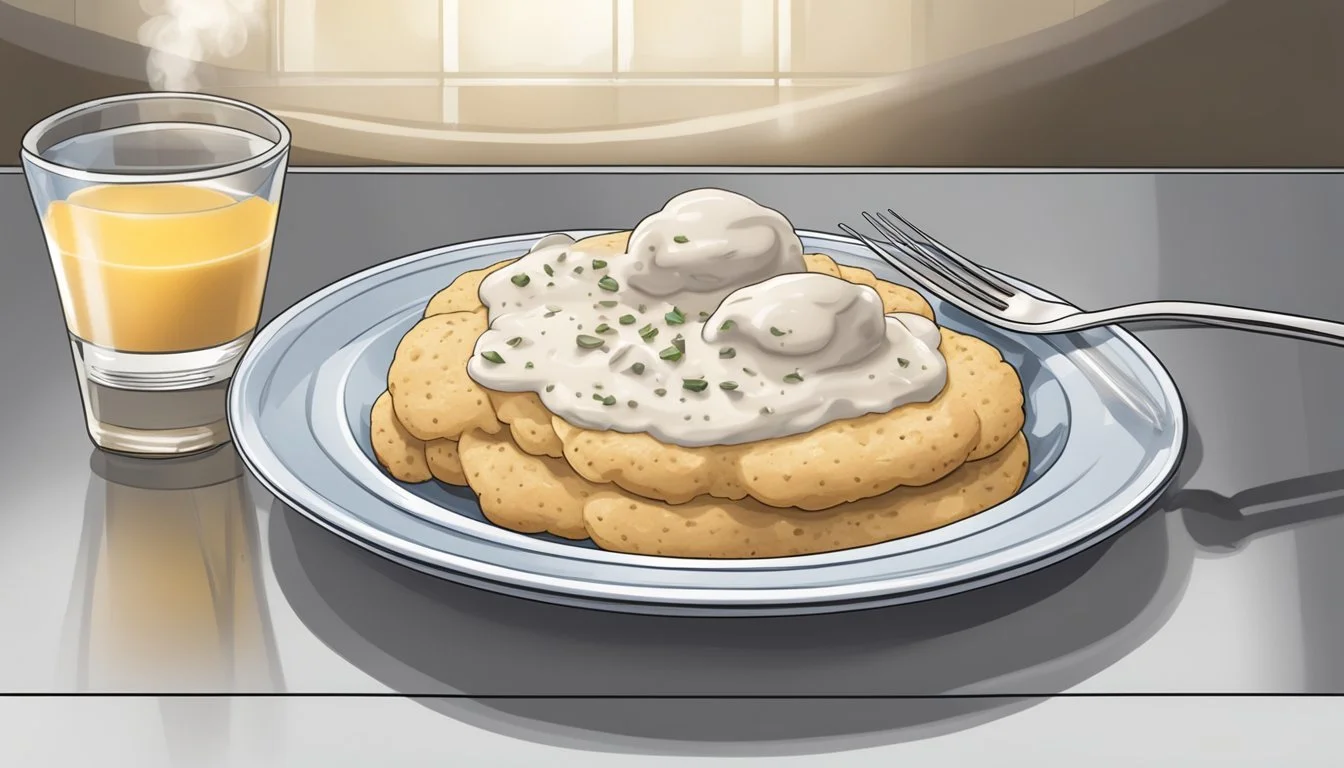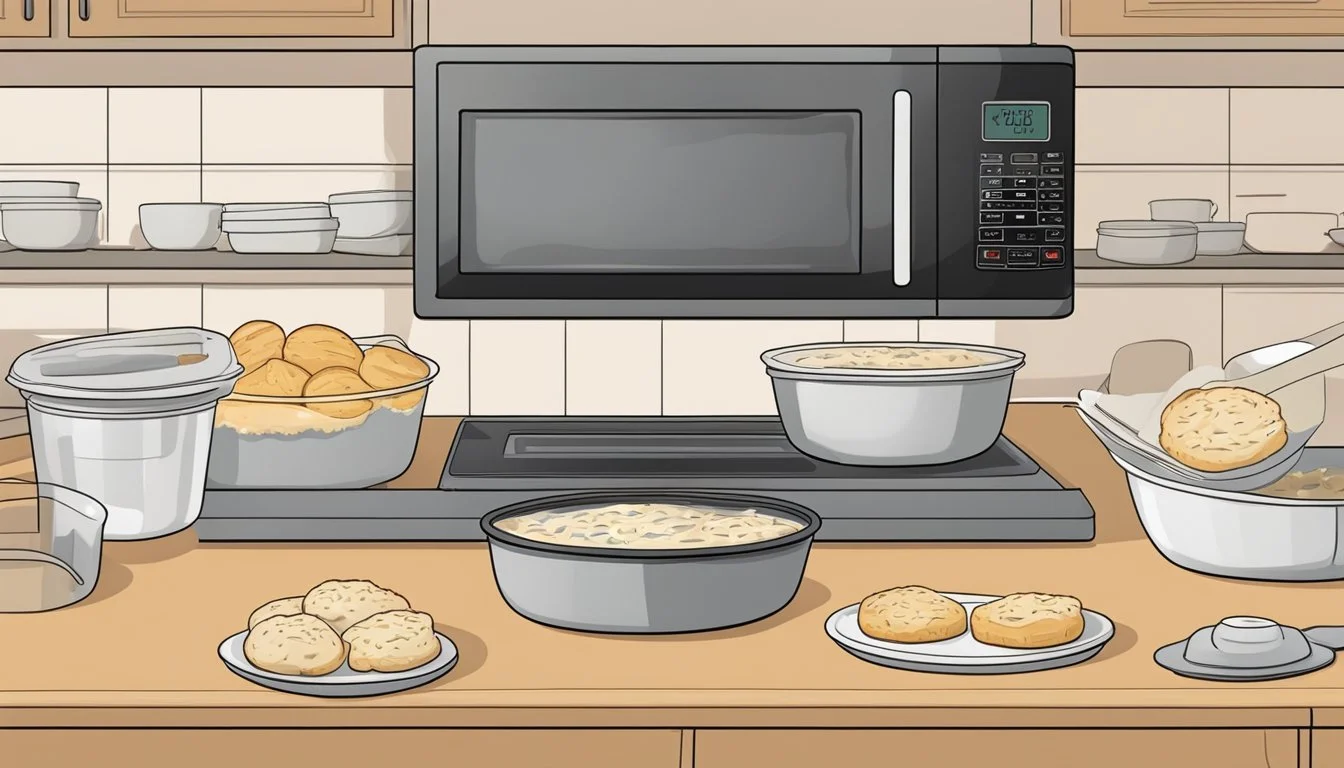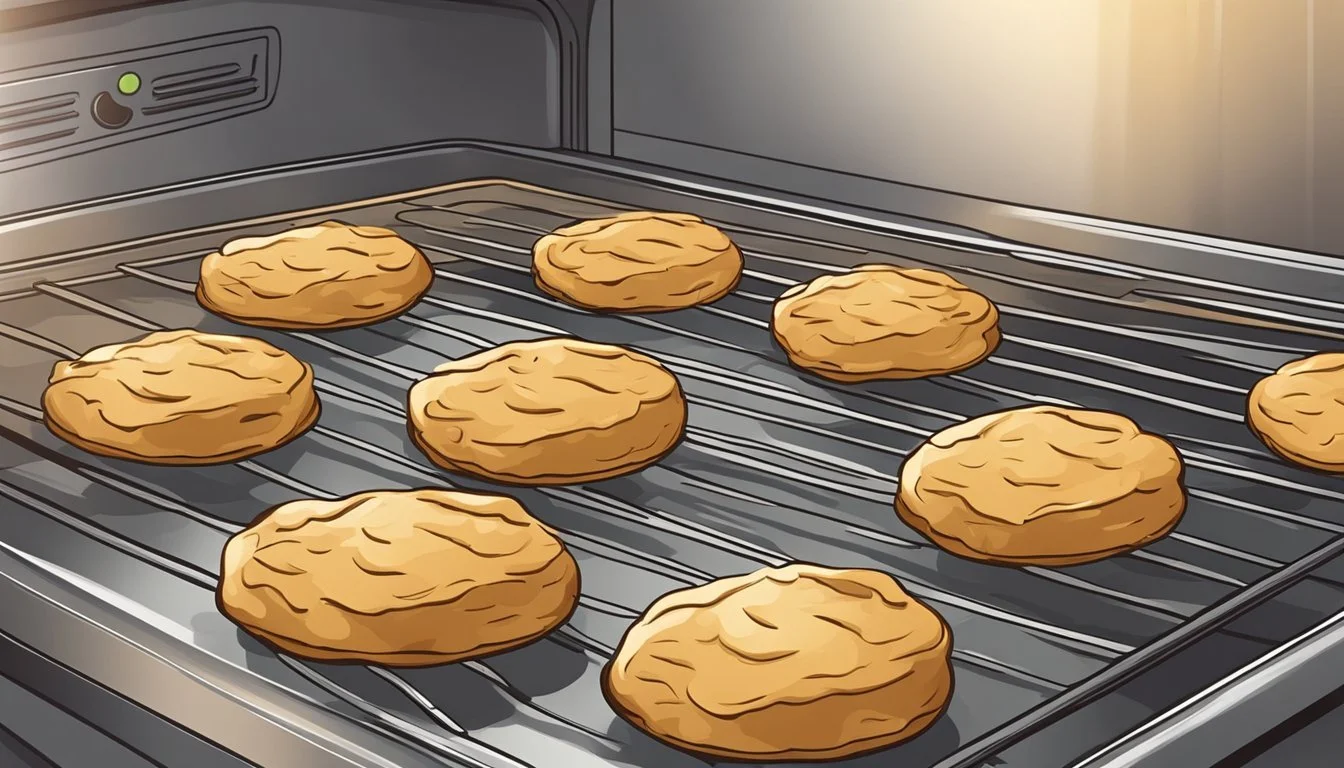How to Reheat Biscuits and Gravy
Simple Steps for Perfect Results
For anyone who loves comfort food, there's nothing quite like biscuits and gravy. When it comes to reheating these delights, the best way to ensure your leftovers taste as delicious as the day they were made is to reheat your biscuits in the oven and your gravy on the stovetop. This method retains the original textures and flavors, making for a satisfying meal.
To reheat biscuits, preheat your oven to 350°F (175°C). Place the biscuits on a parchment-lined baking tray and bake for 12-15 minutes or until they're warm throughout. For added flavor, brush the tops with melted butter once they're out of the oven.
Gravy, on the other hand, should be reheated gently on the stovetop. Place it in a saucepan over medium heat, stirring occasionally until it's heated through. For a quicker option, the microwave can also be used, but always ensure the gravy is covered to avoid splattering and to retain moisture.
Understanding Biscuits and Gravy
Biscuits and gravy is a classic comfort food that combines tender, buttery biscuits with a rich, savory gravy. The balance of textures and flavors elevates this dish to a beloved status in many households.
What Makes Biscuits Special
Biscuits are known for their flaky, tender texture and rich, buttery flavor. Key ingredients often include flour, buttermilk, butter, and baking powder. Buttermilk biscuits are particularly prized for their slight tang and moist crumb. When baked, homemade biscuits develop a golden-brown crust that contrasts beautifully with their soft interior.
Buttery biscuits owe much of their appeal to the generous use of cold butter, which creates pockets of steam during baking, resulting in a flaky texture. The balance of moisture and flavor is essential, making each bite satisfying.
The Role of Gravy in Flavor and Moisture
Gravy adds a layer of savory richness that complements the biscuits perfectly. Typically made from a roux of flour and fat (such as sausage drippings), and then thinned with milk or cream, the gravy provides essential moisture. Seasonings like black pepper, salt, and sometimes herbs amplify its depth.
The combination of the smooth, creamy gravy with the flaky biscuit creates a harmonious dish. The gravy's moisture keeps the biscuits soft, making each bite more enjoyable. Together, they offer a comforting balance of textures and flavors, creating a delicious experience that is both hearty and fulfilling.
Storing Leftovers Properly
Proper storage of biscuits and gravy is essential to maintain their flavor and texture. Different strategies are used depending on whether they will be stored in the refrigerator or freezer, and protecting them from moisture loss is critical.
Fridge vs. Freezer Storage
Biscuits and gravy can be stored in the refrigerator if they will be consumed within a few days. Place the biscuits in an airtight container to prevent them from drying out. Gravy should be stored separately in a sealed container to maintain its consistency.
For longer storage, the freezer is the best option. Wrap biscuits individually in plastic wrap or aluminum foil before placing them in a freezer bag. For the gravy, use a freezer-safe container, leaving some room for expansion. This method helps retain the freshness and prevents ice crystals from forming.
Protecting Against Moisture Loss
To avoid moisture loss in biscuits, airtight storage is crucial. Wrapping them in plastic wrap and then placing them in an airtight container works well. This dual-layer protection keeps them from becoming stale.
Gravy can be particularly prone to drying out. Store it in a sealed container, ensuring that the lid fits tightly. If condensation forms, dab it off with a paper towel before sealing the container. You can also place plastic wrap directly on the surface of the gravy within the container to minimize air exposure.
Pre-Reheating Preparation
Proper preparation is key to reheating biscuits and gravy effectively. This involves setting up your kitchen area and ensuring the biscuits are at the right temperature for reheating.
Setting Up for Optimal Reheating
Start by gathering all necessary items such as a baking tray, parchment paper, and aluminum foil. These materials help ensure even heating and prevent sticking. Preheat your oven to 350°F (175°C) to maintain consistency in reheating the biscuits.
For stovetop reheating, a frying pan or griddle should be heated over medium heat. If using a microwave, prepare a damp paper towel to keep the moisture content of the biscuits. When reheating gravy, have a small saucepan and chicken stock ready.
Bringing Biscuits to Room Temperature
Before reheating, allow the leftover biscuits to come to room temperature. This step reduces reheating time and promotes even warming. Simply place the biscuits on a counter for about 10-15 minutes.
This process prevents the biscuits from becoming too hard or unevenly heated. It’s particularly useful if the biscuits were stored in a refrigerator. Taking this extra step can make a significant difference in texture and taste.
Reheating Biscuits in the Oven
Reheating biscuits in the oven is a reliable method that ensures they remain warm, flaky, and golden brown. This method requires careful attention to oven temperature and the use of a baking sheet to ensure even heating.
Oven Temperature and Timing
For optimal results, preheat the oven to 350°F (175°C). Ensure the oven is fully preheated before placing the biscuits inside. This temperature is ideal for reheating while preventing the biscuits from drying out.
Place the biscuits on a baking sheet lined with parchment paper. Space them out evenly to allow for adequate air circulation. Reheat the biscuits for approximately 8-10 minutes, checking halfway through to prevent over-browning. If the biscuits are particularly thick, an additional 2-3 minutes may be necessary. Use an oven mitt and be cautious when handling the hot baking sheet.
Using a Baking Sheet for Even Heating
A baking sheet is crucial for even heating. Line it with parchment paper to prevent sticking and to aid in easy cleanup. Space the biscuits evenly on the sheet, ensuring they are not touching.
Using a baking sheet helps maintain the texture and structure of the biscuits. It also allows for better heat distribution compared to other methods. If desired, you can cover the biscuits loosely with aluminum foil during the first half of the reheating process to retain moisture. Remove the foil halfway through to achieve a crisp, golden-brown exterior. This technique ensures the biscuits are heated thoroughly and uniformly without drying out.
Reheating Biscuits in a Toaster Oven
Using a toaster oven to reheat biscuits is a quick and convenient method that yields a crispy exterior. Ensuring the correct toaster oven settings and monitoring the process are key to achieving optimal results.
Toaster Oven Settings
Set the toaster oven to 350°F (175°C). Preheat for a few minutes to ensure even heating. Placing the biscuits on a baking sheet lined with parchment paper or aluminum foil helps prevent sticking and mess.
For added flavor, brush melted butter on the tops of the biscuits. This step keeps the biscuits moist and enhances taste. If evenly spaced about an inch apart, each biscuit will reheat uniformly without sticking together.
Monitoring for Desired Crispiness
Check the biscuits frequently while they reheat in the toaster oven. The typical reheating time is 6-8 minutes, but this may vary depending on the toaster oven's efficiency. If left too long, biscuits can dry out or burn.
To achieve a crispy exterior, carefully monitor the biscuits’ progress. If desired, flip them halfway through the reheating process to ensure even crisping on both sides. Use a timer to avoid overcooking and check periodically for the desired level of crispiness.
Reheating Biscuits in the Microwave
When reheating biscuits in the microwave, it's crucial to ensure they remain moist and don't become hard. Two key techniques help achieve this: using paper towels to avoid sogginess and applying short bursts of heat.
Avoiding Sogginess with Paper Towels
To prevent sogginess, place the biscuits on a microwave-safe plate. Cover the biscuits with a moist paper towel. This method retains moisture without making the biscuits wet. The steam from the paper towel helps keep the biscuits soft.
Make sure the paper towel is damp but not dripping. This balance provides the needed steam. Placing biscuits too close together can make them soggy. Proper spacing allows even heat distribution.
Short Bursts of Heat
Set the microwave to 50% power or utilize the "defrost" mode if available. Lower power settings help maintain a soft texture by heating the biscuits gradually. Higher power can lead to biscuits becoming tough.
Heat the biscuits in short intervals of 10-15 seconds. After each interval, check for desired warmth. Repeating this process avoids overcooking. This gradual heating ensures they remain fluffy and soft.
Avoid stacking biscuits directly on top of each other. Utilize single layers for optimal results. Use additional low-power intervals if needed to achieve thorough heating.
Reheating Biscuits on the Stovetop
Reheating biscuits on the stovetop can bring back their warm, fresh-out-of-the-oven texture when done correctly. This method requires attention to detail, using the right equipment and appropriate heat settings.
Choosing the Right Pan
Selecting the right pan is crucial. A non-stick skillet is highly recommended as it prevents the biscuits from sticking and ensures even heating. Original cast iron skillets can also be used but might require additional butter or oil for lubrication.
Prepare the pan by melting a bit of butter in it. The butter not only adds flavor but also helps in achieving a nice, crisp texture on the biscuits’ surfaces. Ensure that the biscuits are placed cut side down to maximize their exposure to direct heat.
Low Heat for Gentle Warming
Using low heat is essential for even warming without burning. Start by setting the stove to a low-medium setting. This helps the biscuits heat through without the risk of charring or overcooking.
Once the pan is sufficiently warm, place the biscuits cut side down. Flip them after 2-3 minutes to ensure both sides are evenly heated. Keep turning them at intervals and monitor closely to avoid overheating.
By maintaining a gentle heat, the biscuits will regain their original fluffiness. Taking care not to rush this process is vital for achieving the best texture and flavor.
Using an Air Fryer for Reheating
Reheating biscuits and gravy with an air fryer presents a convenient way to achieve a crispy exterior while maintaining a soft interior. Key factors to consider include temperature control and precise timing.
Air Fryer Temperature Control
Setting the correct temperature is essential for effective reheating. For optimal results, preheat the air fryer to 350°F. This temperature is hot enough to reheat the biscuits thoroughly without drying them out.
Ensure the biscuits are placed in a single layer in the air fryer basket. Avoid overcrowding to allow proper air circulation, which promotes even reheating.
Keeping the temperature slightly lower, around 330°F to 350°F, can reduce the risk of burning while ensuring a crispy exterior. Monitoring the temperature and making small adjustments as needed can improve the outcome.
Timing for Perfect Crispiness
Timing is critical for achieving the right texture. For refrigerated biscuits, reheat them for about 4-5 minutes. If the biscuits are frozen, extend the time to 8-10 minutes at 380°F.
Check the biscuits halfway through to ensure they are heating evenly. This quick check helps to avoid overcooking or burning. For gravy, it's best to reheat separately in the microwave for 1-3 minutes to maintain the creamy texture without over-drying.
By carefully managing time, you can enjoy biscuits with a crispy exterior and a tender, warm interior, enhancing the overall dining experience.
Reheating Gravy
Gravy can be tricky to reheat without losing its original taste and texture. Using these methods will help you retain the richness and consistency of your gravy.
Stovetop Reheating Method
To reheat gravy on the stovetop, start by pouring it into a saucepan. Add a small amount of liquid, like chicken stock, to prevent it from becoming too thick. Set the burner to low heat to avoid burning or overcooking.
Stir the gravy frequently with a whisk to ensure even heating. Continuous stirring helps avoid lumps and keeps the gravy smooth. If the gravy begins to thicken too much as it heats up, add more chicken stock gradually until the desired consistency is achieved.
Steps:
Pour gravy into a saucepan.
Add a small amount of chicken stock.
Set to low heat.
Stir frequently.
Adjust with more stock if needed.
Maintaining Consistency and Flavor
Ensuring that the gravy remains rich and flavorful after reheating is key. Starting with half a cup of chicken stock brought to a boil before adding the gravy can help balance the consistency. Once the initial mixture is warm, slowly add the remaining gravy while continuously whisking.
Maintaining low heat is crucial throughout the process. This prevents it from separating or becoming too watery. Additionally, taste the gravy and adjust the seasoning if necessary. Adding a pinch of salt or a small pat of butter can enhance its flavor just before serving.
Key Tips:
Begin with boiling half a cup of chicken stock.
Add the gravy slowly, whisking continuously.
Keep the heat low.
Adjust seasoning as needed.
This method helps deliver a reheated gravy that is just as delicious and smooth as when it was first made.
Serving and Pairing Suggestions
Pairing your reheated biscuits and gravy with complementary flavors and sides enhances the dining experience. These suggestions will help you create a complete and satisfying meal.
Completing the Meal
To create a hearty breakfast, serve reheated biscuits and gravy with scrambled eggs or bacon. These classic breakfast items add protein and balance to the rich, creamy gravy.
For a lighter option, consider adding a side salad of mixed greens with a tangy vinaigrette. The acidity of the dressing can cut through the heaviness of the gravy.
On special occasions like Thanksgiving, pair biscuits and gravy with cranberry sauce. The tartness of the cranberries provides a refreshing contrast.
Creative Serving Ideas
Add variety by topping biscuits and gravy with a sprinkle of fresh herbs like parsley or chives, enhancing both flavor and presentation.
For a unique twist, try spreading butter and jam on the biscuits before adding the gravy. This sweet and savory combination is perfect for those who enjoy unconventional pairings.
If serving as an afternoon snack, consider pairing with a cold glass of iced tea or a warm cup of coffee. These beverages complement the savory dish, making it a delightful treat at any time of day.
Experiment with these ideas to keep your mealtime interesting and enjoyable.
Safety and Food Quality
When reheating biscuits and gravy, ensuring both safety and optimal flavor is crucial. This involves maintaining the right temperature and preventing any bacterial growth.
Understanding Reheating Safety
Food safety is paramount when dealing with leftovers. Bacteria can develop rapidly if food is not handled correctly. Proper reheating kills any potential bacterial growth.
Temperature is a crucial factor. Reheat biscuits to at least 165°F (74°C) to eliminate bacteria. Use a thermometer to confirm the internal temperature.
For leftover gravy, bring it to a boil and then simmer to ensure it’s thoroughly heated. Avoid reheating gravy more than once to minimize the risk of bacterial contamination.
Ensuring Quality and Enjoyment
Maintaining quality during reheating is essential for enjoying biscuits and gravy as intended. Even heating is key.
Reheat biscuits in a 350°F (175°C) oven for 12-15 minutes. Brushing them with melted butter can enhance flavor and texture.
For gravy, reheating it in a saucepan on the stove with added chicken stock ensures it remains smooth and flavorful. Whisk constantly to avoid lumps and achieve a desirable consistency.
By following these steps, you can enjoy reheated biscuits and gravy that are safe and delicious.




